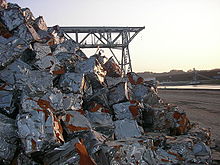Ferrous metal recycling

Ferrous metals are able to be recycled with steel being one of the most recycled materials in the world,[1] . Ferrous metals contain an appreciable percentage of iron and the addition of carbon and other substances creates steel.
The most commonly recycled items are containers, automobiles, appliances, and construction materials. For example, in 2008, more than 97% of structural steel and 106% of automobiles were recycled, comparing the current steel consumption for each industry with the amount of recycled steel being produced (the late 2000s recession and the associated sharp decline in automobile production explains the over-100% calculation).[2] A typical appliance is about 75% steel by weight[3] and automobiles are about 65% steel and iron.[4]
The steel industry has been actively recycling for more than 150 years, in large part because it is economically advantageous to do so. It is cheaper to recycle steel than to mine iron ore and manipulate it through the production process to form new steel. Steel does not lose any of its inherent physical properties during the recycling process, and has drastically reduced energy and material requirements compared with refinement from iron ore. The energy saved by recycling reduces the annual energy consumption of the industry by about 75%, which is enough to power eighteen million homes for one year.[5]
Basic oxygen steelmaking (BOS) steelmaking uses between 25 and 35% recycled steel to make new steel. BOS steel usually has less residual elements in it, such as copper, nickel and molybdenum and is therefore more malleable than electric arc furnace (EAF) steel so it is often used to make automotive fenders, soup cans, industrial drums or any product with a large degree of cold working. EAF steelmaking uses almost 100% recycled steel. This steel contains more residual elements that cannot be removed through the application of oxygen and lime so it is used to make structural beams, plates, reinforcing bar and other products that require little cold working.[6] Recycling one ton of steel saves 1,100 kilograms of iron ore, 630 kilograms of coal, and 55 kilograms of limestone.[7]
Recycling by country
This section needs expansion. You can help by adding to it. (September 2010) |
United States
As of 2008 more than 83% of steel was recycled in the United States.[2] It is the most widely recycled material; in 2000, more than 60 million metric tons were recycled.[1][8]
See also
References
- ^ a b Hartman, Roy A. (2009). "Recycling". Encarta. Archived from the original on 2008-04-14.
- ^ a b "Steel Recycling Rates at a Glance". Archived from the original (PDF) on 2010-02-20. Retrieved 2010-02-20.
- ^ "Recycling steel appliances". Retrieved 2009-07-13.
- ^ "Steel: Driving auto recycling success". Retrieved 2009-07-13.
- ^ "Facts About Steel Recycling". Retrieved 2009-07-18.
- ^ "Steel". Retrieved 2009-07-13.
- ^ "Information on Recycling Steel Products". WasteCap of Massachusetts. Archived from the original on 2007-10-11. Retrieved 2007-02-28.
- ^ "2005 Minerals Handbook" (PDF). February 2007. Retrieved 2008-06-15.
